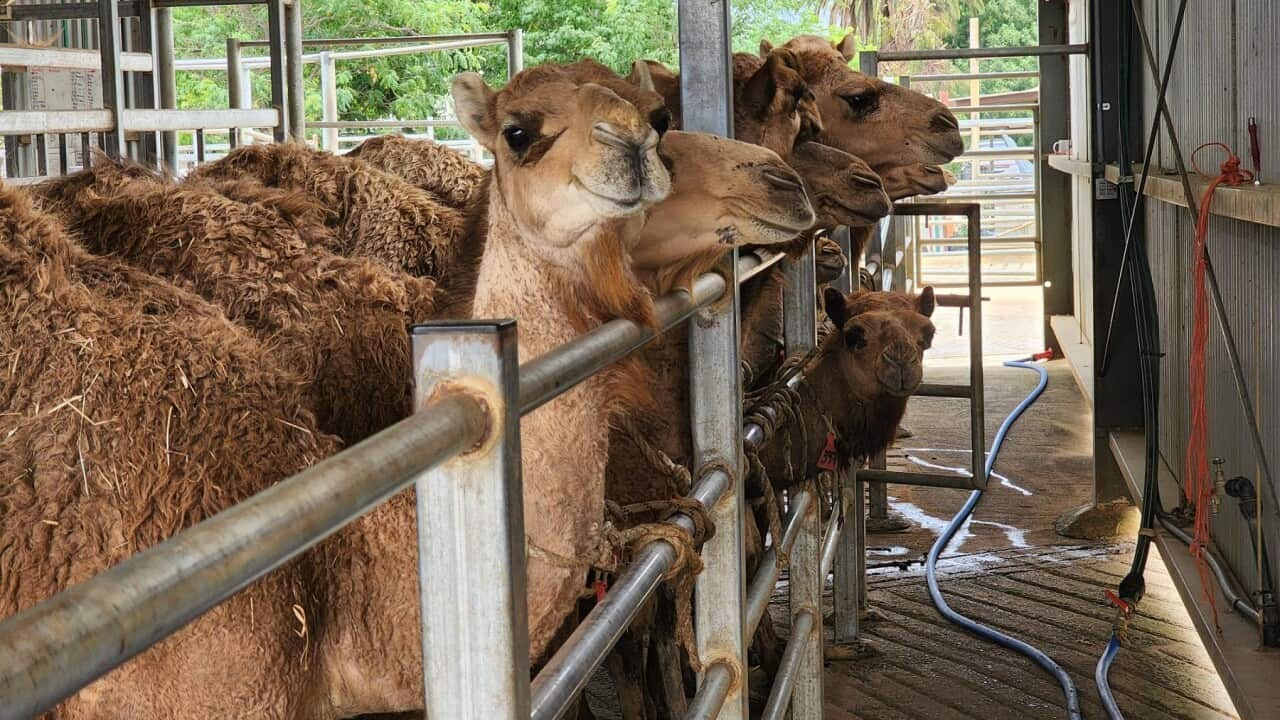English
After growing up on a dairy farm, Megan Williams thought she'd try her hand at something a little different.
For the past eight years, she's been farming camels for milk in Victoria's north, at Kyabram.
“They're really family animals. I think camels are sometimes a bit misunderstood, a lot of people say they can kick, they can spit, they can bite, and that's all very true they can do all of that - but you'd have to be doing something to upset the camel for it to want to do that. They're tight-knit family groups, they never like being left on their own, even if we have one we need to be working with we will always give it a friend to have so it's not always on its own.”
Traditionally popular with middle eastern and African communities, it's a small industry in Australia with only a handful of camel dairies across the country.
Megan Williams has long been spruiking the benefits of drinking camel milk, often a substitute of cow variety.
“So the first notable difference in camel milk is its colour: it's really really white compared to cows' milk. Nutritionally it's naturally low in fat, it's low in lactose and it's high in calcium, magnesium, potassium and iron, even has vitamin C in it.”
And now new research suggests it could have another use - as a part-treatment for people with type 2 diabetes.
Dr Kristy DiGiacomo from the University of Melbourne led a study looking into the effects of camel milk on pigs.
“What we were looking it is using a pig as a model because it has a really similar digestive system to humans so it's good to show what might happen. We fed the camel milk to the pigs and we actually showed they were able to maintain a steady glucose concentration in their blood without having to use extra insulin, so they were somehow able to use that insulin a little bit more effectively.”
Glucose, a form of sugar, is turned into energy by the hormone insulin, which is produced in the pancreas.
For people with type 2 diabetes, insulin isn't able to regulate blood glucose levels.
Too much glucose in the blood can lead to a range of health issues.
Camel milk contains insulin and insulin-like peptides that Dr Kristy DiGiacomo says might work to help someone with diabetes maintain a healthy level of glucose.
“It's about three times more than what's in cows milk but it's thought they might be less resistant to digestion in the stomach so they might be a little bit more effective. It's not conclusive whether that's what's actually having the effect, it might be other parts of the camel milk for example the antioxidants that help with the downstream insulin actions, so whether it's helping with insulin receptors or how the insulin is working in the cells, there's really not a lot of evidence to show exactly how it's working yet.”
Megan Williams says the research backs up what she has been hearing from some of her customers that have diabetes.
“We hear a lot of anecdotal evidence about camel milk, we have customers drink it for that very reason, but I suppose having some scientific evidence in the background is a huge win, yeah.”
Although researchers have been buoyed by these early results into the potential benefits of camel milk, they say more studies are needed to better understand how it works to reduce glucose in the blood.
Dr Kristy DiGiacomo says Diabetes Victoria and the CSIRO are among those eager to see more research in this space.
“Yeah well this was a really small study and obviously we used animals as a model so we need more research to firstly understand how the camel milk is working, what it's actually doing. There's a little bit of elsewhere in the world looking at this but it's not conclusive as yet, and then and then of course moving into human trials, looking into what it does in diabetic type 1 or type 2 humans.”
Italian
Dopo esser cresciuta in un’azienda lattiero/casearia, Megan Williams ha pensato di provare a fare qualcosa di diverso.
Negli ultimi otto anni, ha allevato cammelli da latte nel nord del Victoria, a Kyabram.
“They're really family animals. I think camels are sometimes a bit misunderstood, a lot of people say they can kick, they can spit, they can bite, and that's all very true they can do all of that - but you'd have to be doing something to upset the camel for it to want to do that. They're tight-knit family groups, they never like being left on their own, even if we have one we need to be working with we will always give it a friend to have so it's not always on its own.”
Quella del latte di cammello, tradizionalmente diffusa nelle comunità medio-orientali ed africane, è un-industria ancora ridotta in Australia, con solo una manciata di aziende in tutta la nazione.
Megan Williams promuove da tempo gli effetti benefici del latte di cammello, usato spesso un succedaneo del latte vaccino.
“So the first notable difference in camel milk is its colour: it's really really white compared to cows' milk. Nutritionally it's naturally low in fat, it's low in lactose and it's high in calcium, magnesium, potassium and iron, even has vitamin C in it.”
Adesso, una nuova ricerca ne suggerisce un ulteriore uso, ossia come parte di terapie per persone con diabete di tipo 2.
La dottoressa Kristy Di Giacomo dell’Università di Melbourne ha condotto uno studio che analizza l’effetto del latte di cammello nei maiali.
“What we were looking it is using a pig as a model because it has a really similar digestive system to humans so it's good to show what might happen. We fed the camel milk to the pigs and we actually showed they were able to maintain a steady glucose concentration in their blood without having to use extra insulin, so they were somehow able to use that insulin a little bit more effectively.”
Il glucosio è un tipo di zucchero che viene trasformato in energia dall’insulina, un ormone prodotto nel pancreas.
Per le persone che soffrono di diabete di tipo 2, l’insulina non riesce a regolare i livelli di glucosio nel sangue.
Troppo glucosio nel sangue potrebbe causare una serie di problemi alla salute.
Il latte di cammello contiene insulina e peptidi simili all’insulina che la dottoressa Di Giacomo ritiene possano aiutare persone diabetiche a mantenere un sano livello di glucosio.
“It's about three times more than what's in cows milk but it's thought they might be less resistant to digestion in the stomach so they might be a little bit more effective. It's not conclusive whether that's what's actually having the effect, it might be other parts of the camel milk for example the antioxidants that help with the downstream insulin actions, so whether it's helping with insulin receptors or how the insulin is working in the cells, there's really not a lot of evidence to show exactly how it's working yet.”
Megan Williams ha detto che la ricerca conferma quello che lei ha sentito dire dai suoi clienti che soffrono di diabete.
“We hear a lot of anecdotal evidence about camel milk, we have customers drink it for that very reason, but I suppose having some scientific evidence in the background is a huge win, yeah.”
Sebbene i ricercatori siano stati incoraggiati dai primi risultati sui potenziali benefìci del latte di cammello, sostengono altresì che serviranno più ricerche per capire meglio il modo in cui questo latte riduce il tasso di glucosio nel sangue.
La dottoressa Kristy DiGiacomo ha detto che Diabetes Victoria e la commissione per la ricerca scientifica ed industriale del Commonwealth (il CSIRO) sono tra gli enti più desiderosi di vedere più ricerche in questo ambito.
“Yeah well this was a really small study and obviously we used animals as a model so we need more research to firstly understand how the camel milk is working, what it's actually doing. There's a little bit of elsewhere in the world looking at this but it's not conclusive as yet, and then and then of course moving into human trials, looking into what it does in diabetic type 1 or type 2 humans.”
Report by Sean Wales for SBS News.
Ascolta tutti i giorni, dalle 8am alle 10am. Seguici su , e o abbonati ai nostri podcast cliccando .




